20122012 年 年年全国健美操联赛全国健美操联赛((((威海站
- 格式:pdf
- 大小:426.18 KB
- 文档页数:13
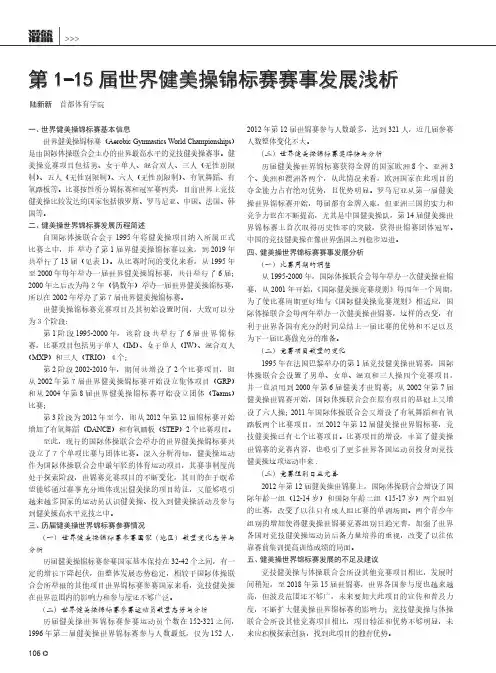
106第1-15届世界健美操锦标赛赛事发展浅析陆新新 首都体育学院一、世界健美操锦标赛基本信息世界健美操锦标赛(Aerobic Gymnastics World Championships )是由国际体操联合会主办的世界最高水平的竞技健美操赛事。
健美操竞赛项目包括男、女子单人、混合双人、三人(无性别限制)、五人(无性别限制)、六人(无性别限制)、有氧舞蹈、有氧踏板等。
比赛按性质分锦标赛和冠军赛两类,目前世界上竞技健美操比较发达的国家包括俄罗斯、罗马尼亚、中国、法国、韩国等。
二、健美操世界锦标赛发展历程简述自国际体操联合会于1995年将健美操项目纳入所属正式比赛之中,并 举办了第1届界健美操锦标赛以来,到2019年共举行了13届(见表1)。
从比赛时间的变化来看,从1995年至2000年每年举办一届世界健美操锦标赛,共计举行了6届;2000年之后改为每2年(偶数年)举办一届世界健美操锦标赛,所以在2002年举办了第7届世界健美操锦标赛。
世健美操锦标赛竞赛项目及其初始设置时间,大致可以分为3个阶段:第1阶段1995-2000年,该阶段共举行了6届世界锦标赛,比赛项目包括男子单人(IM )、女子单人(IW )、混合双人(MXP )和三人(TRIO )4个;第2阶段2002-2010年,期间共增设了2个比赛项目,即从2002年第7届世界健美操锦标赛开始设立集体项目(GRP )和从2004年第8届世界健美操锦标赛开始设立团体(Teams )比赛;第3阶段为2012年至今,即从2012年第12届锦标赛开始增加了有氧舞蹈(DANCE )和有氧踏板(STEP )2个比赛项目。
至此,现行的国际体操联合会举办的世界健美操锦标赛共设立了7个单项比赛与团体比赛。
深入分析得知,健美操运动作为国际体操联合会中最年轻的体育运动项目,其赛事制度尚处于探索阶段,世锦赛竞赛项目的不断变化,其目的在于既希望能够通过赛事充分地体现出健美操的项目特征,又能够吸引越来越多国家的运动员认识健美操、投入到健美操活动及参与到健美操高水平竞技之中。
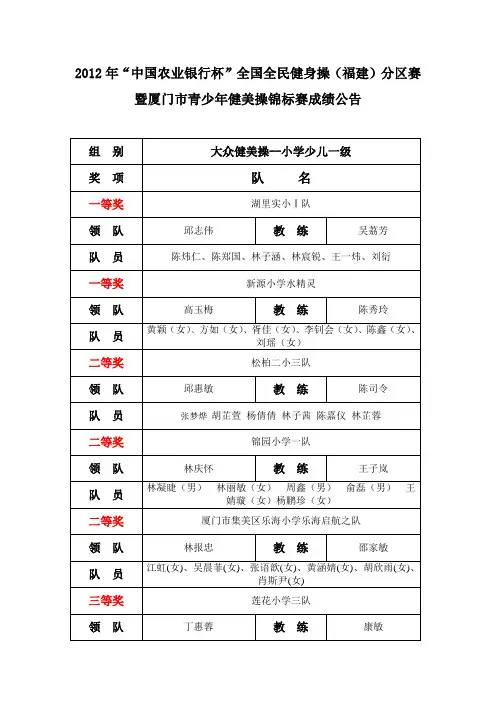
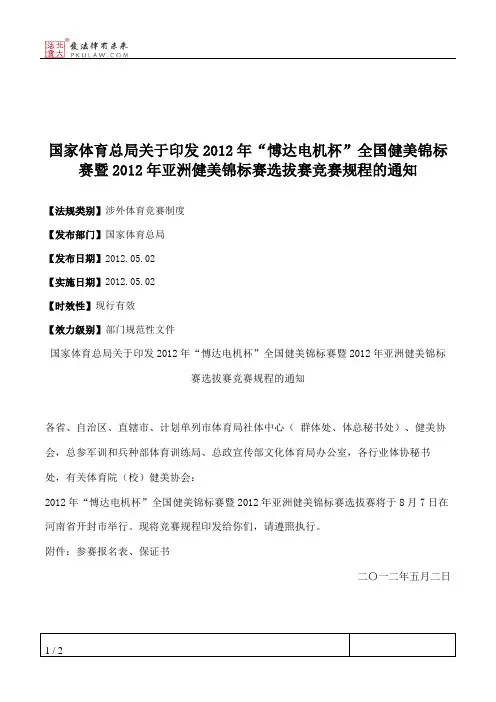
国家体育总局关于印发2012年“愽达电机杯”全国健美锦标赛暨2012年亚洲健美锦标赛选拔赛竞赛规程的通知
【法规类别】涉外体育竞赛制度
【发布部门】国家体育总局
【发布日期】2012.05.02
【实施日期】2012.05.02
【时效性】现行有效
【效力级别】部门规范性文件
国家体育总局关于印发2012年“愽达电机杯”全国健美锦标赛暨2012年亚洲健美锦标
赛选拔赛竞赛规程的通知
各省、自治区、直辖市、计划单列市体育局社体中心(群体处、体总秘书处)、健美协会,总参军训和兵种部体育训练局、总政宣传部文化体育局办公室,各行业体协秘书处,有关体育院(校)健美协会:
2012年“愽达电机杯”全国健美锦标赛暨2012年亚洲健美锦标赛选拔赛将于8月7日在河南省开封市举行。
现将竞赛规程印发给你们,请遵照执行。
附件:参赛报名表、保证书
二〇一二年五月二日附件1:2012年“愽达电机杯”全国健美锦标赛暨2012年亚洲健美锦标赛选拔赛报名表
队名
领队(限1人)教练员(限2人),_______________ 联系地址联系人
邮政编码传真电话。
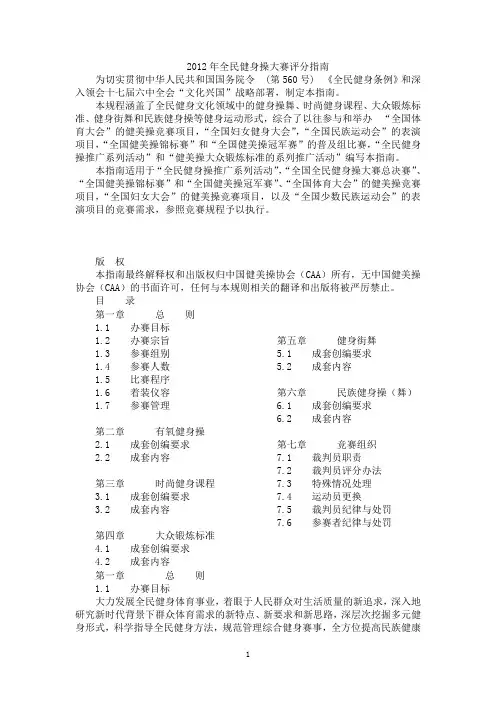
2012年全民健身操大赛评分指南为切实贯彻中华人民共和国国务院令(第560号) 《全民健身条例》和深入领会十七届六中全会“文化兴国”战略部署,制定本指南。
本规程涵盖了全民健身文化领域中的健身操舞、时尚健身课程、大众锻炼标准、健身街舞和民族健身操等健身运动形式,综合了以往参与和举办“全国体育大会”的健美操竞赛项目,“全国妇女健身大会”,“全国民族运动会”的表演项目,“全国健美操锦标赛”和“全国健美操冠军赛”的普及组比赛,“全民健身操推广系列活动”和“健美操大众锻炼标准的系列推广活动”编写本指南。
本指南适用于“全民健身操推广系列活动”,“全国全民健身操大赛总决赛”、“全国健美操锦标赛”和“全国健美操冠军赛”、“全国体育大会”的健美操竞赛项目,“全国妇女大会”的健美操竞赛项目,以及“全国少数民族运动会”的表演项目的竞赛需求,参照竞赛规程予以执行。
版权本指南最终解释权和出版权归中国健美操协会(CAA)所有,无中国健美操协会(CAA)的书面许可,任何与本规则相关的翻译和出版将被严厉禁止。
目录第一章总则1.1 办赛目标1.2 办赛宗旨1.3 参赛组别1.4 参赛人数1.5 比赛程序1.6 着装仪容1.7 参赛管理第二章有氧健身操2.1 成套创编要求2.2 成套内容第三章时尚健身课程3.1 成套创编要求3.2 成套内容第四章大众锻炼标准4.1 成套创编要求4.2 成套内容第五章健身街舞5.1 成套创编要求5.2 成套内容第六章民族健身操(舞)6.1 成套创编要求6.2 成套内容第七章竞赛组织7.1 裁判员职责7.2 裁判员评分办法7.3 特殊情况处理7.4 运动员更换7.5 裁判员纪律与处罚7.6 参赛者纪律与处罚第一章总则1.1 办赛目标大力发展全民健身体育事业,着眼于人民群众对生活质量的新追求,深入地研究新时代背景下群众体育需求的新特点、新要求和新思路,深层次挖掘多元健身形式,科学指导全民健身方法,规范管理综合健身赛事,全方位提高民族健康水平。
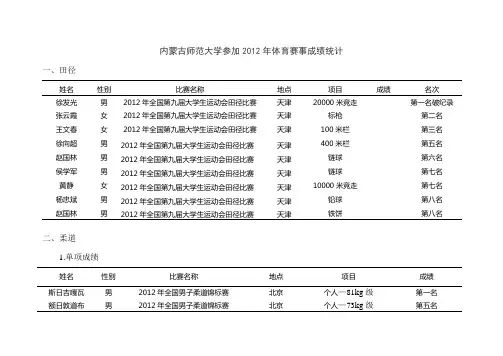
内蒙古师范大学参加2012年体育赛事成绩统计一、田径姓名性别比赛名称地点项目成绩名次徐发光男2012年全国第九届大学生运动会田径比赛天津20000米竞走第一名破纪录张云霞女2012年全国第九届大学生运动会田径比赛天津标枪第二名王文春女2012年全国第九届大学生运动会田径比赛天津100米栏第三名徐向超男2012年全国第九届大学生运动会田径比赛天津400米栏第五名赵国林男2012年全国第九届大学生运动会田径比赛天津链球第六名侯学军男2012年全国第九届大学生运动会田径比赛天津链球第七名黄静女2012年全国第九届大学生运动会田径比赛天津10000米竞走第七名杨忠斌男2012年全国第九届大学生运动会田径比赛天津铅球第八名赵国林男2012年全国第九届大学生运动会田径比赛天津铁饼第八名二、柔道1.单项成绩姓名性别比赛名称地点项目成绩斯日吉嘎瓦男2012年全国男子柔道锦标赛北京个人—81kg级第一名额日敦道布男2012年全国男子柔道锦标赛北京个人—73kg级第五名2.团体成绩比赛名称成绩主办单位承办单位领队教练2012年全国大学生男女柔道锦标赛男团第五名国家体育总局摔柔中心陕西宝鸡包呼格吉乐图孟和宝力格2012年全国大学生男女柔道锦标赛女团第五名国家体育总局摔柔中心陕西宝鸡包呼格吉乐图孟和宝力格三、搏克1.单项成绩姓名性别比赛名称地点成绩乌云高娃女2012年全区大学生搏克锦标赛呼和浩特民族学院第一名郝琴女2012年全区大学生搏克锦标赛呼和浩特民族学院第二名2.团体成绩比赛名称成绩主办单位承办单位领队教练员2012年全区大学生搏克锦标赛男团第一名内蒙古教育厅呼和浩特民族学院包呼格吉乐图孟和宝力格2012年全区大学生搏克锦标赛女团第一名内蒙古教育厅呼和浩特民族学院包呼格吉乐图孟和宝力格四、健身气功1.单项成绩姓名性别比赛名称地点成绩刘宇星女2012年全国高等院校健身气功比赛山西大同第一名边金凤女2012年全国高等院校健身气功比赛山西大同第二名卢凤祥男2012年全国高等院校健身气功比赛山西大同第二名浩特拉特古斯男2012年全国高等院校健身气功比赛山西大同第二名2.团体成绩比赛名称成绩主办单位承办单位领队教练2012年全国高等院校健身气功比赛六字诀第一名国家体育总局健身气功中心山西大同包呼格吉乐图张彩琴2012年全国高等院校健身气功比赛五禽戏第二名国家体育总局健身气功中心山西大同包呼格吉乐图张彩琴五、网球1.单项成绩姓名性别比赛名称地点项目成绩胡德尔扎那男2012年全区高校网球邀请赛内蒙古工业大学男子单打第二名高佳女 2012年全区高校网球邀请赛内蒙古工业大学女子单打第七名2.团体成绩比赛名称成绩主办单位承办单位领队教练2012年全区高校网球邀请赛学生组男团第二名内蒙古自治区教育厅内蒙古工业大学包呼格吉乐图德木其格2012年全区高校网球邀请赛男子双打第三名内蒙古自治区教育厅内蒙古工业大学包呼格吉乐图德木其格六、脚斗士比赛名称成绩主办单位承办单位领队教练2012“武夷山·阿里山”海峡两岸脚斗士大赛男团第二名全国脚斗士大赛推广委员会武夷山包呼格吉乐图张建强七、自行车比赛名称成绩主办单位承办单位领队教练2012年环青海湖国际大学生公路自行车赛男团第二名阿拉腾图力古尔个人第二国家体育总局社会体育指导中心青海西宁包呼格吉乐图布仁巴图八、健美操比赛名称成绩主办单位承办单位领队教练2012年“浩沙杯”第十一届全国万人健美操大众锻炼标准大赛分区赛比赛一等奖国家体育总局体操运动管理中心内蒙古体育局包呼格吉乐图周雅宁2012年全区大学生健美操比赛二等奖内蒙古自治区教育厅内蒙古师范大学包呼格吉乐图周雅宁九、足球比赛名称成绩主办单位承办单位领队教练2012年全区大学生足球锦标赛女团第一名内蒙古自治区教育厅内蒙古大学赵文斌张晓明,岳鹏十、篮球比赛名称成绩主办单位承办单位领队教练2012年全区大学生篮球锦标赛男团第一名内蒙古自治区教育厅包头师范学院包呼格吉乐图张磊2012年全区大学生篮球锦标赛女团第三名内蒙古自治区教育厅包头师范学院包呼格吉乐图张慧升十一、排球比赛名称成绩主办单位承办单位领队教练2012年全区大学生排球锦标赛男团第三名内蒙古自治区教育厅通辽职业学院包呼格吉乐图杨玉根内蒙古师范大学高水平运动队管理委员会办公室2013年6月9日星期日。
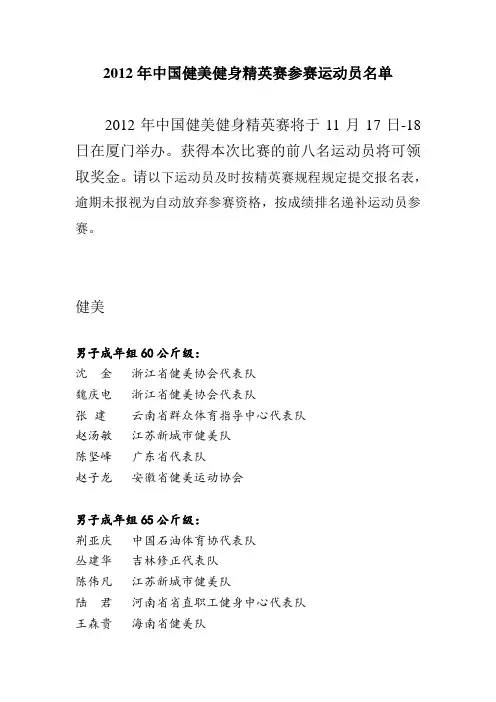
2012年中国健美健身精英赛参赛运动员名单2012年中国健美健身精英赛将于11月17日-18日在厦门举办。
获得本次比赛的前八名运动员将可领取奖金。
请以下运动员及时按精英赛规程规定提交报名表,逾期未报视为自动放弃参赛资格,按成绩排名递补运动员参赛。
健美男子成年组60公斤级:沈金浙江省健美协会代表队魏庆电浙江省健美协会代表队张建云南省群众体育指导中心代表队赵汤敏江苏新城市健美队陈坚峰广东省代表队赵子龙安徽省健美运动协会男子成年组65公斤级:荆亚庆中国石油体育协代表队丛建华吉林修正代表队陈伟凡江苏新城市健美队陆君河南省省直职工健身中心代表队王森贵海南省健美队曹玮山东省代表队男子成年组70公斤级:冉茂荣深圳鑫信诺投资发展有限公司代表队王伟山东省代表队党智勇安徽省健美运动协会钱海龙云南群众体育指导中心代表队陈北月江苏新城市健美队王旺城福建省社体中心男子成年组75公斤级:王华江苏省代表队程灿灿河南省省直职工健身中心代表队庄广友深圳凯利达健身中心代表队张甫来浙江省健美协会代表队周波吉林修正代表队周建荣浙江省健美协会男子成年组80公斤级:辛健山东省代表队刘金晓江苏新城市健美队陈康江苏新城市健美队胡建浙江省健美协会代表队熊明海南省健美队男子成年组85公斤级:贾勇河南省省直职工健身中心代表队丁毓涛山东省代表队段惊雷开封市代表队许旭重庆市健美队柳付猛开封市代表队孙乐乐365百姓健身上海体院健美队女子成年组49公斤级:刘红霞河南省省直职工健身中心代表队唐淑娟安徽省健美运动协会田爱莲江苏新城市健美队祁敏安徽省健美运动协会章乱365百姓健身上海体院健美队孙玉平山东省代表队女子成年组52公斤级:向再华安徽省健美运动协会郑卫娟深圳凯利达健身中心代表队许雪丹江苏新城市健美队毛学贝湖北省青舞舞蹈培训学院魏艳霞西安石油大学郭笑潇开封市代表队女子成年组55公斤级:翟宝珍河南省省直职工健身中心代表队周扬新疆健美协会顾娟365百姓健身上海体院健美队印淑慧西安石油大学姜晔睿365百姓健身上海体院健美队任静河南体育运动学校体育舞蹈专业代表队女子成年组58公斤级:崔颖河南省省直职工健身中心代表队叶萍365百姓健身上海体院健美队白新红山东省代表队黄玲深圳凯利达健身中心代表队李爱军河南省省直职工健身中心代表队陈晓桐开封市代表队健身健身小姐A组(扬州赛区)孙瑞芬安徽省健美运动协会林玲扬州佰瑞特健身发展有限公司白姗姗连云港市代表队沈珍珍扬州佰瑞特健身发展有限公司管潇婷浙江省衢州学院健身健美代表队丁秀秀365百姓健身代表队(郑州赛区)刘晨河南省省直职工健身中心代表队杨慧山西省代表队林燕燕河南焦作369健身学院代表队吾英湖北江汉大学文理学院代表队曹润青河南省省直职工健身中心代表队郭向喆湖北江汉大学文理学院代表队健身小姐B组(扬州赛区)牟丛安徽省健美运动协会汪俊含海南省代表队刘莉青海省健美操健身健美协会朱娴扬州佰瑞特健身发展有限公司陈洁瑶扬州佰瑞特健身发展有限公司(郑州赛区)韩李美萱华东师范大学代表队孙青西安体育学院代表队马宁宁山东黑骏马健身代表队孙诗阳四川师范大学代表队郑明兰河南省省直职工健身中心代表队彭胜超山西省代表队健身先生A组(扬州赛区)郑少忠河北省廊坊师范学院吴成虎大卫山道国际健身王鲁杰鸿宝伦(北京)体育文化发展有限公司黄欣广州邦禾健身美容会所代表队王一鸣安徽师范大学代表队顾斌扬州佰瑞特健身发展有限公司(郑州赛区)崔靳超河南焦作369健身学院代表队敖东生吉林省健美代表队廖中明亚商学院代表队徐华龙河南焦作369健身学院代表队史咏麟河南省省直职工健身中心代表队高少怀河南省省直职工健身中心代表队健身先生B组(扬州赛区)杨枭扬州佰瑞特健身发展有限公司林福尧广州邦禾健身美容会所代表队汪尚安徽省健美运动协会周伟浙江省衢州学院健身健美代表队王成365百姓健身代表队汤勇扬州佰瑞特健身发展有限公司(郑州赛区)陈箭春湖北江汉大学文理学院代表队谢明四川师范大学代表队张少帆西安体育学院代表队巴连助河南大学公共体育部代表队邢桂恒河南省省直职工健身中心代表队女子形体健身A组(扬州赛区)孙瑞芬安徽省健美运动协会赖莛莛上海体院盛政文化传播有限公司张蓓大卫山道国际健身白姗姗连云港市代表队许雪丹扬州佰瑞特健身发展有限公司管潇婷浙江省衢州学院健身健美代表队(郑州赛区)李玲四川师范大学代表队赵玲玲四川师范大学代表队刘琳河南省省直职工健身中心代表队焦景倩河南省省直职工健身中心代表队刘晨河南省省直职工健身中心代表队张晓芳山东黑骏马健身代表队女子形体健身B组(扬州赛区)牟丛安徽省健美运动协会汪俊含海南省代表队蒋文文扬州佰瑞特健身发展有限公司翁小红浙江省衢州学院健身健美代表队王向曼连云港市代表队星野磨里扬州佰瑞特健身发展有限公司(郑州赛区)石玉岩四川师范大学代表队印淑慧西安石油大学庞雅静西安体育学院代表队魏丹妮四川师范大学代表队刘劲松山东黑骏马健身代表队胡怡河南省省直职工健身中心代表队男子形体健身A组(扬州赛区)何章明安徽省健美运动协会郑少忠河北省廊坊师范学院王鲁杰鸿宝伦(北京)体育文化发展有限公司吴成虎大卫山道国际健身黄欣广州邦禾健身美容会所代表队马培厂中国煤矿体育协会(郑州赛区)袁锐兴西安体育学院代表队曾峰华湖北江汉大学文理学院代表队陆遥湖北江汉大学文理学院代表队周凯河南焦作369健身学院代表队陈建华河南省省直职工健身中心代表队刁星智北京体育大学代表队男子形体健身B组(扬州赛区)曹辉宁夏队林福尧广州邦禾健身美容会所代表队张彤安徽省健美运动协会郭孔成大卫山道国际健身吴贝贝安徽省健美运动协会蔡寅辉广州市力美健健身俱乐部(郑州赛区)费冀粤河南省省直职工健身中心代表队曹浩佳中南民族大学代表队李文斌河南省省直职工健身中心代表队谢明四川师范大学代表队李侃北京体育大学代表队尹强强湖北江汉大学文理学院代表队女子体育模特A组(扬州赛区)张蓓大卫山道国际健身张媛媛安徽省健美运动协会林玲扬州佰瑞特健身发展有限公司戴秀秀扬州佰瑞特健身发展有限公司朱娴扬州佰瑞特健身发展有限公司王向曼连云港市代表队(郑州赛区)庞雅静西安体育学院代表队李玲四川师范大学代表队刘琳河南省省直职工健身中心代表队马睿吉林省健美代表队焦景倩河南省省直职工健身中心代表队陈诗思四川师范大学代表队女子体育模特B组(扬州赛区)汪萌扬州佰瑞特健身发展有限公司王琦安徽师范大学代表队陈洁瑶扬州佰瑞特健身发展有限公司李双双安徽师范大学代表队翁小红浙江省衢州学院健身健美代表队周清扬州佰瑞特健身发展有限公司(郑州赛区)王艳坤四川师范大学代表队洪程程西安体育学院代表队马宁宁山东黑骏马健身代表队杨悦河南省省直职工健身中心代表队刘劲松山东黑骏马健身代表队胡怡河南省省直职工健身中心代表队男子体育模特A组(扬州赛区)王健安徽省健美运动协会何祚斌大卫山道国际健身李慧创启天地郭孔成大卫山道国际健身张涛安徽省健美运动协会赵海洋扬州佰瑞特健身发展有限公司(郑州赛区)曹浩佳中南民族大学代表队叶天琪湖北江汉大学文理学院代表队刘富涛山东黑骏马健身代表队申天恩河南焦作369健身学院代表队杨涛河南焦作369健身学院代表队林曦湖北江汉大学文理学院代表队男子体育模特B组(扬州赛区)张彤安徽省健美运动协会蔡寅辉广州市力美健健身俱乐部杨枭扬州佰瑞特健身发展有限公司郭龙威安徽师范大学代表队狄龙生上海体院盛政文化传播有限公司郭江龙大卫山道国际健身(郑州赛区)隋永毅山东黑骏马健身代表队李根西安石油大学竺小龙新疆健美协会代表队崔明奋河南焦作369学院代表队冶建辉新疆健美协会代表队李文斌河南省省直职工健身中心代表队。
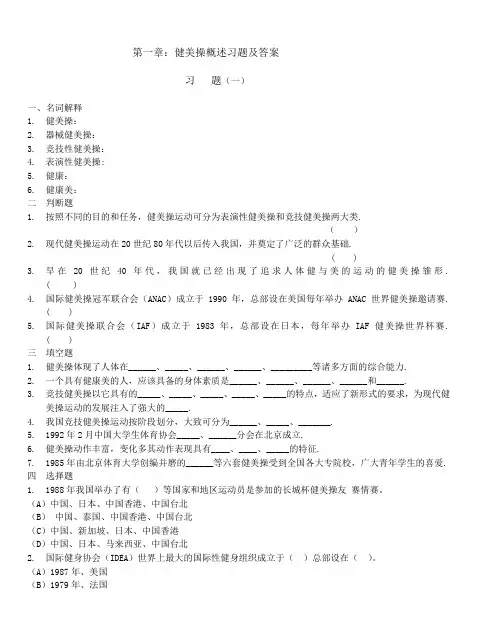
第一章:健美操概述习题及答案习题(一)一、名词解释1.健美操:2.器械健美操:3.竞技性健美操:4.表演性健美操:5.健康:6.健康美:二判断题1.按照不同的目的和任务,健美操运动可分为表演性健美操和竞技健美操两大类.()2.现代健美操运动在20世纪80年代以后传入我国,并奠定了广泛的群众基础.( )3.早在20世纪40年代,我国就已经出现了追求人体健与美的运动的健美操雏形.( )4.国际健美操冠军联合会(ANAC)成立于1990年,总部设在美国每年举办ANAC世界健美操邀请赛.( )5.国际健美操联合会(IAF)成立于1983年,总部设在日本,每年举办IAF健美操世界杯赛.( )三填空题1.健美操体现了人体在______、_____、______、______、_________等诸多方面的综合能力.2.一个具有健康美的人,应该具备的身体素质是______、______、______、______和______.3.竞技健美操以它具有的_____、_____、_____、_____、_____的特点,适应了新形式的要求,为现代健美操运动的发展注入了强大的_____.4.我国竞技健美操运动按阶段划分,大致可分为______、_____、_______.5.1992年2月中国大学生体育协会_____、______分会在北京成立.6.健美操动作丰富,变化多其动作表现具有____、____、_____的特征.7.1985年由北京体育大学创编并磨的______等六套健美操受到全国各大专院校,广大青年学生的喜爱.四选择题1.1988年我国举办了有()等国家和地区运动员是参加的长城杯健美操友赛情赛。
(A)中国、日本、中国香港、中国台北(B)中国、泰国、中国香港、中国台北(C)中国、新加坡、日本、中国香港(D)中国、日本、马来西亚、中国台北2.国际健身协会(IDEA)世界上最大的国际性健身组织成立于()总部设在()。
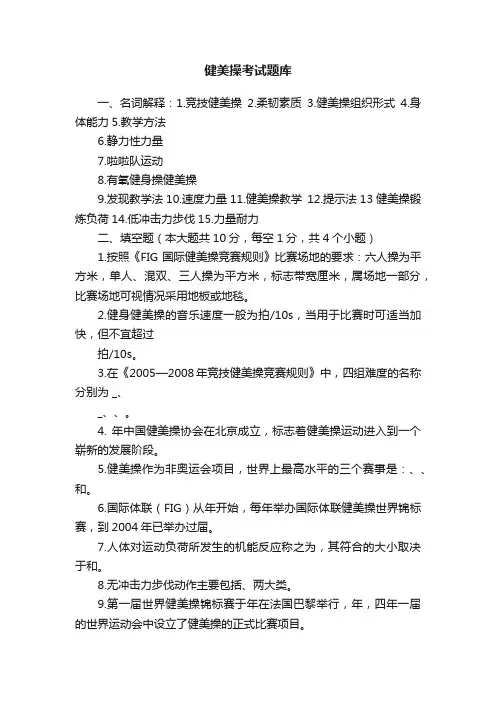
健美操考试题库一、名词解释:1.竞技健美操2.柔韧素质3.健美操组织形式4.身体能力5.教学方法6.静力性力量7.啦啦队运动8.有氧健身操健美操9.发现教学法10.速度力量11.健美操教学12.提示法13健美操锻炼负荷14.低冲击力步伐15.力量耐力二、填空题(本大题共10分,每空1分,共4个小题)1.按照《FIG国际健美操竞赛规则》比赛场地的要求:六人操为平方米,单人、混双、三人操为平方米,标志带宽厘米,属场地一部分,比赛场地可视情况采用地板或地毯。
2.健身健美操的音乐速度一般为拍/10s,当用于比赛时可适当加快,但不宜超过拍/10s。
3.在《2005—2008年竞技健美操竞赛规则》中,四组难度的名称分别为 _、_、、。
4. 年中国健美操协会在北京成立,标志着健美操运动进入到一个崭新的发展阶段。
5.健美操作为非奥运会项目,世界上最高水平的三个赛事是:、、和。
6.国际体联(FIG)从年开始,每年举办国际体联健美操世界锦标赛,到2004年已举办过届。
7.人体对运动负荷所发生的机能反应称之为,其符合的大小取决于和。
8.无冲击力步伐动作主要包括、两大类。
9.第一届世界健美操锦标赛于年在法国巴黎举行,年,四年一届的世界运动会中设立了健美操的正式比赛项目。
10.健美操按照不同的目的和任务可分为和,健身健美操还可分为、和。
11.通常我们把作为评价健美操运动负荷适宜度的客观依据。
12.啦啦队运动始创于_____年代的美国校园,最早出现在校园体育比赛中,是观众为本队加油呐喊的一种表演形式。
13.健美操力量素质的发展主要是体现在、、和这四种力量的发展上。
14.发展柔韧素质的练习的基本方法包括和两种方法。
15.国际竞技健美操比赛项目有、、、和五个项目。
16.我们通常把健身效果的最佳心率区间定在每分钟次。
17.健美操的基本动作训练主要包括、、。
三、选择题(本大题共10分,每题2分,共5个小题)1.下列哪种不属于班级授课的具体形式_______。
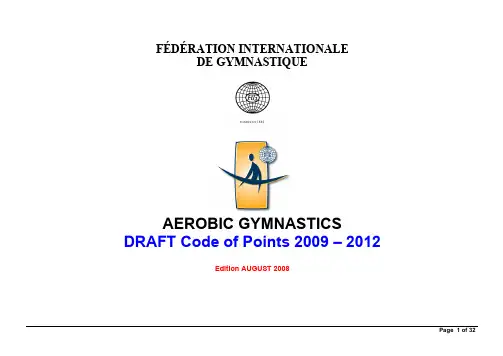
FÉDÉRATION INTERNATIONALEDE GYMNASTIQUEFONDÉE EN 1881AEROBIC GYMNASTICS DRAFT Code of Points 2009 – 2012Edition AUGUST 2008This Code of Points should be approved by the FIG Executive Committee to use from 1st January 2009.Please note that this Code of Points which also contains a number of technical aspects should be read in conjunction with the FIG Statutes and Technical Regulations. In cases of contradiction between the Code of Points and the Technical Regulations, the Technical Regulations take precedence.Copyright:The Code of Points is the property of the FIG.Any translation or reproduction of the Code is strictly prohibited without the prior written consent of the FIG.INTRODUCTION OF THE FIG CODE OF POINTS OF AEROBIC GYMNASTICS - EDITION 2009 - 2012By John ATKINSON - President FIG Aerobic Gymnastics CommitteeThe FIG Aerobic Gymnastics Technical Committee is pleased to provide this final DRAFT of the Code of Points 2009 – 2012 to the FIG EC and the FIG Members Federations, proposed for implementation January 1st 2009.The Code of Points has taken into account suggestions made bya. The FIG Continental Unions Aerobic Gymnastics Technical Committeeb. FIG Member Federationsc. IAF / ANAC.d. International Experts and FIG Aerobic Gymnastics Working Group Experts.e. FIG Aerobic Gymnastics Athletes Representativef. FIG Aerobic Gymnastics Technical Committee MembersThe most important changes are reflected in :• FIG Code of Points Artistic contents and Appendix 1 rewritten• The roles, responsabilities and rights of the Superior Jury, Chair of Judges panel, Difficulty Judges and Judges were reviewed and approved by the FIG Executive, May 2007• Execution simplified with accompanying illustrated tables of deductions.• Written description in Appendix II reviewed and corrected• Minimum requirements reviewed and some Difficulty values readjusted• Categories IM & IW : length of exercise 1’30” and 10 difficulty elements• Co-efficient for Trios and Groups: 1.9 point for Women and Mixed categories, 2.0 points for Men categories• Floor area : 7m X 7m for Individual and 10 m X 10m for MP, TR and GR• The lifts have been reviewed in the light of prohibited elementsI wish to thank the present Aerobic Gymnastics Technical Committee for their unstinting work in creating this new Code of Points and on behalf of the Aerobic GymnasticsTechnical Committee, I wish also to thank N.Vieru (ROU) for his recommendations, advice and support during the last two cycles.IMPRESSUMAll of the members of the FIG Aerobic Gymnastics Committee contributed to the revision of this Code of Points.John Atkinson President GBRHans van der Krogt Secretary NEDMaria Mineva Vice President BULSergio Garcia Vice President ESPTammy Yagi Kitagawa Member JPNMaria Fumea Member ROMMireille Ganzin Member FRAThe Aerobic Gymnastics Technical Committee wishes to thank Dr. P.Wade (GBR) and Tonya Case (USA) President and Vice-President of the Acrobatics Gymnastics Technical Committee, Fernando Leon (COL ANAC), co-opted FIG Aerobic Gymnastics TC Member and the following persons for their contribution:Drawings:Elena Krioutchek RUSGerald Bidault FRAMarina Aagaard Salminen DENCopyright by FIGThis Code incl. Appendices or parts of it may not be copied or translated without the written approval of FIGTABLE OF CONTENTSCHAPTER 1 GENERAL INFORMATION1.1 AEROBIC GYMNASTICS10Definition 101.2 The Code of Points10A General Purpose 10B Judges 10C Superior Jury 101.3 Competitions 11Status 111.4 Competition programme 11A Periods 11B Competition schedule 111.5 Entry Procedures for World Championships 11 1.6 Name Changes 111.7 Qualification Rounds and Finals 11A Number of Participants in the Qualification Round 11B Number of Participants in the Finals 11C Tie Breaking Rules 11D Ranking team 111.8 Starting Order 12A Drawing lots 12B Walk over 12 1.9 Facilities 12A Training area 12B Waiting area 121.10 National emblem - advertising logo 121.11 Podium and Competition Floor 13A Podium 13B Competition floor and area 13C. Seating 13D Restrictions 141.12 Musical accompaniment 14A Equipment 14B Recording 14C Quality 14D Music Rights 141.13 Results 14A Display and distribution of results 14B Protests 14C Final Results 141.14 Awards 14A Ceremonies 14B Awards 14CHAPTER 2THE WORLD CHAMPIONSHIPS IN AEROBIC GYMNASTICS2.1 Categories 15A Number of categories 15B Number of competitors 152.2 Participation criteria 15A General rights 15B Age 15C Nationality 15 2.3 Dress Code 16A Profile 16B Attire 16C Uniform 16CHAPTER 3 COMPOSITION OF ROUTINES3.1 Special Requirements 17A Artistic 17B Execution 17C Difficulty 173.2 Composition Contents 17 3.3 Length 17 3.4 Music 17 3.5 Difficulty elements 183.6 Element pool & values 18A Structure 18B Difficulty elements not listed in the pool 18C New difficulty elements 18CHAPTER 4JUDGING 4.1 Composition of the Juries 18A Superior Jury 18B Judges Panel 184.2 Functions and criteria of the Juries 184.2.1 Superior Jury 184.2.2 Judges Panel 21A Artistic 22A.1 The Choerography composition 22A.2 The Aerobic content 23A.3 Presentation and musicality 23B Execution 231 Technical Skill 23a) Form, Posture and Alignment 23b) Precision 23c) Strength, Power, Muscular Endurance 242 Synchronisation (MP – TR – GR ) 24 C Difficulty 24Function 24Criteria 24Scoring 26D Line Judges 26E Chair of Judges Panel 26CHAPTER 5 SCORING5.1 General Principle 30Artistic score 30 Execution score 30 Maximum deviation allowed for Artistic and Execution 30 Difficulty score 30 Total score 30 Final score 30 Maximum deviation between extremes 30 Protests 305.2 Score Chart 31A Additions 31B Deductions 31C Scoring System 31D Scoring Example 31 CHAPTER 6PROHIBITED MOVES AND DISCIPLINARY PENALTIES6.1 Prohibited Moves 32 6.2 Disciplinary Penalties 32A Warnings 32B Disqualification 32CHAPTER 7EXTRAORDINARY CIRCUMSTANCESExtraordinary cirdcumstances 32APPENDIX I GUIDE TO JUDGING ARTISTICAPPENDIX II GUIDE TO JUDGING EXECUTION AND DIFFICULTY APPENDIX III DIFFICULTY TABLES / ELEMENT POOL & VALUESGroup A – Dynamic strengthGroup B – Static strengthGroup C – Jumps and leapsGroup D – Balance & flexibilityAPPENDIX IV SHORTHAND SYMBOLSAPPENDIX V INTERNATIONAL AGE GROUP COMPETITIONCHAPTER 1 GENERAL INFORMATION1.1 AEROBIC GYMNASTICSDEFINITION OF AEROBIC GYMNASTICSAerobic gymnastics is the ability to perform continuous complex and high intensity movement patterns to music, which originate from traditional aerobic exercises : the routine must demonstrate continuous movement, flexibility, strength and the utilisation of the seven basic steps, with perfectly executed difficulty elements.DEFINITION OF AEROBIC MOVEMENT PATTERNSCombinations of basic aerobic steps together with arm movements : all performed to music, to create dynamic, rhythmic and continuous sequences of high and low impact movements.Routines should provide a high level of intensity.1.2 THE CODE OF POINTSA. GENERAL PURPOSEThe Code of Points provides the means of guaranteeing the most objective evaluation of routines in Aerobic Gymnastics at international level.B. JUDGES (see also 4.2.1)Judges must maintain a close involvement with Aerobic Gymnastics and constantly extend their practical knowledge. The basic prerequisites for their activities are:•An excellent knowledge of the FIG Code of Points•An excellent knowledge of the FIG Technical Regulations•An excellent knowledge of new difficulty elements The prerequisites for judging at official FIG competitions are:•to be in possession of a valid FIG Brevet of the current cycle•to have judged successfully at national competitions, at competitions between countries and at international invitationals.•to be listed in the FIG World List of judges•to have an excellent knowledge of Aerobic Gymnastics and to demonstrate sound unbiased judging.All members of the judging panel are obliged to:•attend all meetings, briefings and debriefings•be present at the competition area at the designated time according to the schedule•attend the competition orientation meetingDuring the competition each judge is requested:•not to leave the assigned seat•not to have contact with other persons•not to engage in discussions with coaches, competitors and other judges•to wear the prescribed competition-uniform(women: dark blue suit with skirt or trousers and white blouse)(men: dark blue jacket, grey trousers, light coloured shirt and tie).C. SUPERIOR JURY (see also 4.2.1)The Superior Jury is responsible for controlling the work of all judges and the Chair of Judges Panel according to the rules and to guarantee a correct publication of the final scores. It registers the deviations of the judges' scores.If there are repeated deviations, the Superior Jury has the right to warn and replace a judge.Violations of instructions from the Superior Jury, the Chair of Judges Panel and the Code may result in sanctions, as declared by the President of the FIG Aerobic Gymnastics Committee.Violations of the Code include:•intentional violation of the Code•intentionally giving an advantage or disadvantage to one or several competitors•not adhering to the instructions given by the Aerobic Gymnastics Committee, the Superior Jury or the Chair of Judges Panel•repeatedly giving scores that are too high or too low•not adhering to the instructions for an orderly and disciplined competition •not participating in the judges meetings•improper attireThe following sanctions can be declared by the Superior Jury or the Chair of Judges Panel:•verbal or written warning•exclusion from the respective competitionThe following sanctions can be declared by the Aerobic Gymnastics Committee: •expulsion as a judge from international competitions for a set period of time •lowering the category of brevet•withdrawal of the brevet•not accepting judges from an involved federation for a set period of time (see FIG Judges rules January 2005)1.3 COMPETITIONSSTATUSThe official FIG Aerobic Gymnastics competition is the World Aerobic Gymnastics Championships.1.4 COMPETITION PROGRAMMEA. PERIODSThe World Aerobic Gymnastics Championships are held every two years in the even years.B. COMPETITION SCHEDULEThe general layout for the World Aerobic Gymnastics Championships must be as follows (see T.R. 2008, section 6 art 3.1)Examples• 1st day: Qualifications IM / MP / GR• 2nd day : Qualifications IW / TR• 3rd day : Finals IM / MP - GR - IW / TROR• 1st day: Qualifications & Finals IM / MP• 2nd day : Qualifications & Finals IW / TR• 3rd day : Qualifications & Finals GRThe competitions may not start earlier than 10.00 hours and finish later than 23.00 hours.The competition schedule must be approved by the Aerobic Gymnastics Committee and published in the Work Plan. 1.5 ENTRY PROCEDURES FOR WORLD CHAMPIONSHIPS See Technical Regulations 2008 4.1 and item 2.2. of Chapter 2 of this Code of Points.1.6 NAME CHANGES(See Technical Regulations 2008 4.2) Normally no changes are allowed after the nominative entry. Where there are serious medical reasons exceptions may be made up to 24 hours prior to the competition.The decision is taken by the official representative of the FIG Medical Committee. The request must be made in writing and accompanied by a comprehensive medical report in the English language.1.7 QUALIFYING ROUNDS AND FINALSA. NUMBER OF PARTICIPANTS IN THE QUALIFYING ROUNDSThe maximum number for the Qualifying Rounds is two per category and Nation. (see Technical Regulations 2008 section 6 - 3.2b)B. NUMBER OF PARTICIPANTS IN THE FINALSA maximum of eight Individual Men and Women, Mixed Pairs, Trios or Groups (maximum two per category and nation) may participate in the finals.(see Technical Regulations 2008 section 6 - 3.2c)C. TIE BREAKING RULES(see Technical Regulations 2008 section 6 - 3.3)In case of a tie at any place the tie will be broken based on the following criteria in this order :•the highest total score in Execution•the highest total score in Artistic•the highest total score in Difficulty•all Execution judges scores are taken into consideration (without deleting the highest and the lowest)•the three highest Execution judges scores are taken into consideration•the two highest Execution judges scores are taken into consideration etc. •the highest Execution judge score is taken into consideration etc.•same procedure with the Artistic judges and the Difficulty judges.D. RANKING BY TEAM(see Technical Regulations 2008 section 6 - 3.2 d)1.8 STARTING ORDERA. PROCEDURE FOR DRAWING LOTS(see Technical Regulation 2008 section 1 Art 4.4)A draw will decide the starting order of the qualification rounds and the finals. Lots will be drawn in the presence of the President of the Aerobic Gymnastics TC or a nominated Aerobic Gymnastics TC member.1. The drawing of lots will take place within two weeks after the deadline of thedefinitive entry2. The federations will be informed by the Secretary General at least one monthbeforehand of the time and place of the drawing of lots and they will be entitled to be present at the draw.3. The media will be informed and allowed to send representatives and thelocal authority, in whose area the draw will be held, will be invited to send representatives.4. The lots shall be drawn by a “neutral” person or by computer.5. The draw will decide the order in which the lot for each team or gymnast willbe drawn and determine the order in which the team or gymnast will commence to compete in the competitionB. WALK OVERShould a competitor fail to appear on stage within 20 seconds after being called, a deduction of 0.5 shall be made by the Chair of the Judges Panel. Should a competitor fail to appear on stage within 60 seconds after being called, the start will be deemed as a Walk Over. Upon announcement of such a Walk Over the competitor loses his right to participate in the category in question. In EXTRAORDINARY CIRCUMSTANCES refer to chapter 7.1.9 FACILITIESA. TRAINING AREAA training hall is available to the competitors 2 days prior to the start of the competition. It is equipped with appropriate sound equipment and a full size competition floor. Access to the floor is given by a rotation schedule set up by the Organisers and approved by the Aerobic Gymnastics Committee. B. WAITING AREAA designated area connected to the Podium is referred to as the Waiting Area. It is only to be used by the competitors and their coaches of the next two starts. The area is not allowed to be used by any other person.1.10 NATIONAL EMBLEM - ADVERTISING LOGO1. A gymnast must wear a national identification or emblem on his/her leotard in accordance with the most recent FIG Regulation2 . A gymnast may only wear those logos advertising and sponsorships identifiers that are permitted in the most recent FIG regulations.RULES for ADVERTISING & PUBLICITY “COMPETITION ATTIRE - COMPETITION VENUE – APPARATUS”. FIG 2004The penalties for violations of the above rules and expectation is 0.2 point each time.1.11 PODIUM AND COMPETITION FLOOR A. PODIUMThe podium on which the competition takes place is 80 cm to 140 cm high andclosed off at the rear with a background. The podium is no less than 14 m x 14 mD. RESTRICTIONSCompetitors, coaches and all unauthorised persons are restricted from entering the waiting area during competition, except when called by an official of the OC or the FIG.Coaches have to remain in the Waiting Area while their competitors are competing. Coaches, competitors and all unauthorised persons are restricted from entering the judging area. Disregard of these restrictions may lead to the disqualification of the competitor by the Chair of Judges Panel.1.12 MUSICAL ACCOMPANIMENTA. EQUIPMENTThe quality of the sound equipment must be of a professional standard and include, apart from the regular equipment, the following essential items: separate loud speakers for the competitors. A regular tape deck as well as a CD player. B. RECORDINGOne or more pieces may be mixed. Original music and sound effects are allowed. The music must be recorded on at the very beginning of side A on a regular cassette tape or a CD. Reel to reel is not permitted.Two copies must be brought to the competition and clearly marked with competitor’s name, country and category.C. QUALITYThe tape recording must meet professional standards regarding sound reproduction.D. MUSIC RIGHTSThe FIG and the Organising Committee cannot guarantee that the chosen music for a routine can be broadcast.Together with the nominative entry, a list of all the music, title, artist and composer used must be sent to the the competition organiser and for the World Championships to the FIG Secretariat. 1.13 RESULTSA. DISPLAY AND DISTRIBUTION OF RESULTSThe score given for each competitor by each judge and the final score must be displayed to the public. After the Qualification round, each participating member federation must receive a complete copy of the results. At the end of the competition, a complete set of results must be given to each participating member federation.B. PROTESTSNo protests are allowed against scores or results (For extraordinary circumstances see chapter 7).C. FINAL RESULTSFor each final there is no carry-over score. The classification is determined by the score obtained in the Final.In case of a tie at any place the tie will be broken based on the following criteria in this order :•the highest total score in Execution•the highest total score in Artistic•the highest total score in Difficulty•all Execution judges scores are taken into consideration (without deleting the highest and the lowest)•the three highest Execution judges scores are taken into consideration•the two highest Execution judges scores are taken into consideration etc. •the highest Execution judge score is taken into consideration etc.•same procedure with the Artistic judges and the Difficulty judges.1.14 AWARDS (see T.R. and Statute FIG Art 10.2 - 10.3)A. CEREMONIESSee special regulations for FIG medal award ceremonies. The detailed organisation must be approved by the responsible FIG official.B. AWARDSTrophies are given to the winners of each category and medals to the first three places. Diplomas are given to each finalist.A certificate of participation is given to all competitors and officials.CHAPTER 2 THE WORLD CHAMPIONSHIPS IN AEROBIC GYMNASTICS 2.1 CATEGORIESA. NUMBER OF CATEGORIESThe World Aerobic Gymnastics Championships comprises the following 5 categories:Individual womenIndividual menMixed PairTrioGroups B. NUMBER OF COMPETITORSThe number and sex of the competitors in each category is:Individual women 1 female competitorIndividual men 1 male competitorMixed Pair 1 male / 1 female competitorTrio 3 competitors (males/females/mixed) Groups 6 competitors (males/females/mixed)2.2 PARTICIPATION CRITERIAA. GENERAL RIGHTSThe World Aerobic Gymnastics Championships are open to competitors who:- have been entered by their national federation affiliated to the FIG- fulfil the requirements of the FIG Statutes and the FIG Technical Regulations B. AGE (see T.R. FIG section 1, Art Reg 5.2)For official Senior competitions of the FIG, the participant must, in the year of the competition, have the following competition age : 18 years.C. NATIONALITY (see T.R. FIG section 1, Art Reg 5.3)Competitors and judges who change nationality must follow the Directives of the Olympic Charter and the FIG Statutes.Changes of nationality are dealt with by the FIG Executive Committee.2.3 DRESS CODEThe competitors dress must demonstrate that it subscribes to the sport profile of a Gymnastics discipline. Theatrical, musichall and circus dress is not allowed.A. PROFILEA neat and proper athletic appearance should be the overall impression.1. Hair must be secured close to the head.2. The competitors must wear white aerobics shoes and white socks that mustbe able to be seen by all judges.3. Body paint is not allowed. Make-up must be only for women and usedsparingly.4. Loose items and additions to the attire are not allowed.5. Skin coloured taping is allowed6. Jewellery must not be worn.B. ATTIRE1. Correct aerobics attire must be in non-transparent material andundergarments must not be shown.2. Attire for women may be with or without long sleeves (1 or 2). Longsleeves end at the wrist.3. Leotards must be designed in accordance with the written introduction 2.3.4. Attire for men : only the examples shown under “Men’s attire” areallowed.5. Attire depicting war, violence or religious themes is forbidden.WOMEN`S ATTIRE●Women must wear a one piece leotard with flesh coloured ortransparent tights. A top and trunk (two pieces) or a top and trunkconnected with only strings or bands is not allowed.●The neckline of the front and back of the leotard must be proper (nofurther than half of the sternum for the front and no further than thelower line of the shoulder blades for the back).●The cut of the leotard at the top of the legs must not go higher thanthe waist and the outside seam must pass through the crest ofilium. The leotard must cover the crotch completely.●Examples acceptable for WOMENa b c dThe examples shown “a to c” represent the same front and back of the leotard.The example “d” is the same leotard showing the front and the back.MEN`S ATTIRE●Men must wear a unitard or shorts and a form fitting top or leotard.●The attire must not have an open cut at the front or back.●The armhole must not be cut below shoulder blades (scapular)Acceptable Examples for MENe f g hThe examples shown “ e to h ” represent the same front and back of the leotard. Deductions for : incorrect attire : - 0.2 pt wrong attire : - 2.0 ptC. UNIFORMAt the Opening and Closing Ceremony all competitors must wear their country’s official national tracksuitCompetition attire is required for medal award Ceremonies.CHAPTER 3 COMPOSITION OF ROUTINES3.1 SPECIAL REQUIREMENTSA. ARTISTIC• To meet the artistic requirements, a routine and its choreography must demonstrate creativity and sports specific content. It should also show a variety of movements and a high degree of correlation between the music, movements and the competitors expression.• Themes showing violence and racism, as well as those with religious and sexual connotations, are not in keeping with the Olympic ideals and the FIG’s code of ethics.• For Mixed Pairs, Trios and Groups, three lifts are required in the routine. This may include the opening and ending.B. EXECUTION•All movements must be performed with perfect execution.C. DIFFICULTYIndividuals, Mixed Pairs,Trios and Groups:The routine must show a balance between airborne, standing and floor-work difficulty elements.• A maximum of 12 difficulty elements (MP, TR, GR) or 10 difficulty elements (IM, IW) must be performed by each competitor. Using only the 12 or 10 choosen elements, 2 elements can be combined from the same or different groups, but from different families.•An element which does not meet a minimum requirement is also counted in the 12 or 10 difficulty elements, will receive 0.0 pt value and will not count for the group.•To receive a diificulty value for each group, all the competitors must perform one element from each group without combination.•The difficulty score is the total value of the difficulty elements performed (max12 for MP, TR, GR and max 10 for IM & IW) plus the value of allcombinations.•All difficulty elements performed must be from different families.• A maximum of 6 difficulty elements (MP, TR, GR) or a maximum of 5 difficulty elements (IM, IW) on the floor is allowed including landing on the floor in split and in push up position. • A maximum of 2 difficulty elements from Group C are allowed landing in push up position and a maximum of 2 difficulty elements from group C are allowed landing in split position.Mixed Pairs and Trios:•To receive a difficulty value, all competitors must perform the same element at the same time or consecutively, in the same or different directions (except in a lift).Groups:•At least one element from each group of the element pool must be included. •In order to receive a difficulty value for these four difficulty elements, all competitors of the group must perform the same element at the same time or consecutively, in the same or different directions (except in a lift).•In order to receive a difficulty value for the remaining difficulty elements, the competitors may perform up to two different difficulty elements at the same time or consecutively. Any combination of competitors may perform these two different difficulty elements. (e.g. 1-5, 2-4, 3-3)3.2 COMPOSITION CONTENTSThe routine must show a balance between aerobic movement patterns (combinations of high and low movements), and difficulty elements.Arm and leg patterns must be strong and with a definite shape.It is essential to show a balanced use of all space, the floor surface, and airborne movements.3.3 LENGTHThe length of the routine is 1 minute 45 seconds for MP, TR and GR with a tolerance of plus or minus 5 seconds and 1 minute 30 seconds for Individual Women and Men with a tolerance of plus or minus 5 seconds.3.4 MUSICThe routine must be performed, in its entirety, to music.Any style of music adapted for Aerobic Gymnastics can be used.See Appendix I, Guide to judging Artistic pp 18 – 213.5 DIFFICULTY ELEMENTSThe routine must include a minimum of one element from each of the following groups of the element pool:GROUP A Dynamic strengthGROUP B Static strengthGROUP C Jumps and LeapsGROUP D Balance and FlexibilityA maximum of 12 difficulty elements (MP, TR, GR) or 10 diificulty elements (IM, IW) are allowed.The difficulty elements are optional; however, at International events (Seniors) difficulty elements with the value of 0.1 and 0.2 will not be considered as difficulty elements.3.6 ELEMENT POOL & VALUES (SEE APPENDIX III)A. STRUCTUREThe element pool (see Appendix III) is divided into 4 groups. The difficulty level is ranked from 0.1 to 1.0 point. B. DIFFICULTY ELEMENTS NOT LISTED IN APPENDIX III, ELEMENT POOL & VALUESThe Difficulty Judges are allowed to evaluate on sight difficulty elements not listed in Appendix III, Element Pool & Values with a value of 0.3 point.C. NEW DIFFICULTY ELEMENTSClassification of new difficulty elements can ONLY be made by the Aerobic Gymnastics Committee who will evaluate them once per year. Applications must be sent to the FIG Secretariat. They must be received in writing and accompanied by a video before 31st January.Difficulty elements submitted for evaluation must be filmed from two camera angles - from the front and the side. The difficulty elements must meet the minimum requirements and must be performed on a competition surface or a landing mat no higher than 15 cm. If the above requirements are not met, the Aerobic Gymnastics Committee will refuse to classify the difficulty elements. Notification of the classification will be given to the applying member federation before 30th March.The FIG Secretariat will publish the updated Element Pool once per year only.CHAPTER 4 JUDGING4.1 COMPOSITION OF THE JURIESA. SUPERIOR JURYPresident and Members of the FIG Aerobic GymnasticsTechnical Committee.B. JUDGES PANELS AT WORLD AND CONTINENTAL CHAMPIONSHIPS,WORLD GAMES AND WORLD SERIES EVENTSArtistic Judges 4 Judges No 1-4 Execution Judges 4 Judges No 5-8 Difficulty Judges 2 Judges No 9-10 Line Judges 2 Judges No 11-12 Time Judge 1 Judge No 13 Chair of Judges Panel 1 Judge No 14 Total: 14 4.2 FUNCTIONS AND CRITERIA OF THE JURIES4.2.1 SUPERIOR JURY1. To supervise the competition and to deal with any breaches ofdiscipline or any extraordinary circumstances affecting the running ofthe competition.2. Where there is a grave error of judgement on the part of one, or severaljudges, such action as they consider necessary will be taken.3. Continually, to review the marks awarded by the judges and to issue awarning to any judge whose work is considered to be unsatisfactory orshowing partiality.4. Following the unsatisfactory result of any warning, to remove wherenecessary the offending judge.。
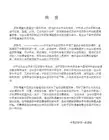
国际体操联合会健美操技术委员会中国健美操协会2010-2012普及组有氧健美操评分规则2010年7月试行本规则由FIG健美操技术委员会提供,中国健美操协会技术委员会翻译修订,将于2010年全国健美操联赛开始予以执行。
本规则中出现的相关技术方面的问题请结合FIG竞技健美操评分规则与CAA2010-2012年全国健美操联赛、锦标赛、冠军赛竞赛规程进行阅读。
若本规则与技术规程之间存在矛盾之处,则以竞赛规程为准。
目录第一章总则1.1 竞赛性质与种类1.2 参赛资格1.3 比赛项目与内容1.4 参赛年龄与分组1.5 比赛成绩1.6 场地1.7 着装与仪容第二章成套创编2.1 成套时间2.2 成套音乐2.3 创编内容2.4 难度动作2.5 轻器械第三章裁判3.1 裁判组的组成3.2 裁判组职责与评分标准3.2.1 艺术裁判职责与评分标准3.2.1.1 艺术裁判组5人3.2.1.2 艺术分10分A)特色内容4分B)形式多样2分C)动感流畅2分D) 表现音乐2分3.2.2 完成裁判职责与评分标准3.2.2.1 完成裁判组3人3.2.2.2 完成分10分A)姿态控制4分B )整齐划一3分C )强度评价3分3.2.3 裁判长职责与裁判长减分3.2.4 嘉宾评委的职责第四章记分4.1 记分方法4.2 最后得分第一章总则1.1 竞赛性质与种类本评分规则适用于中华人民共和国境内,由中国健美操协会指导下的一切普及组有氧健美操竞赛。
由中国健美操协会主办的官方赛事为全国健美操联赛、全国健美操锦标赛和全国健美操冠军赛。
1.2 参赛资格在中国健美操协会进行常规备案的单位具有参赛资格;参加竞技组比赛的运动员不得参加普及组比赛。
1.4 参赛年龄与分组学生组:6~11周岁(小学组)、12~17周岁(中学组)、18周岁以上(大学组)社会组:18~35周岁(青年组)、36~55周岁(中年组)根据比赛需求,为增强与观众互动的效果,可增设两组表演赛:明星组(35岁以下曾经获得全国前三名的运动员)大师组(36岁以上曾经获得全国前三名的运动员)1.5 比赛成绩各比赛组别与项目分为预赛和决赛;预赛成绩决定团体名次,决赛成绩决定单项名次。

国家体育总局关于表彰2012年全民健身活动优秀组织奖和先进单位的决定文章属性•【制定机关】国家体育总局•【公布日期】2012.12.31•【文号】体群字[2012]214号•【施行日期】2012.12.31•【效力等级】部门规范性文件•【时效性】现行有效•【主题分类】体育正文国家体育总局关于表彰2012年全民健身活动优秀组织奖和先进单位的决定(体群字[2012]214号)各省、自治区、直辖市、新疆生产建设兵团体育局,各行业体协,有关单位:2012年是深入实施《全民健身计划(2011-2015年)》(以下简称“《全民健身计划》”)承上启下的关键一年,全国各地、各单位根据国家体育总局的统一部署和要求,结合本地、本单位实际,以科学发展观为统领,以贯彻落实《全民健身计划》为契机,以普及推广第九套广播体操为重点内容,通过创新形式,整合资源,加大宣传力度,广泛开展以“每天锻炼一小时,健康生活一辈子”为主题、贴近生活、丰富多彩、方便参与的体育健身活动,提高广大人民群众主动参与健身的意识,养成良好的体育锻炼习惯,形成了崇尚健身的良好环境和氛围,涌现出一批先进单位和组织。
为鼓励先进,逐步形成组织开展全民健身活动新的工作格局,不断扩大开展全民健身活动的示范效应,经研究,决定授予中国银行股份有限公司北京市分行工会等622个单位“2012年全民健身活动优秀组织奖”、北京市直属机关工会等954个单位“2012年全民健身活动先进单位”,并通报表彰。
附件:2012年全民健身活动优秀组织奖和先进单位名单国家体育总局2012年12月31日附件:2012年度全民健身活动优秀组织奖和先进单位名单一、全民健身活动优秀组织奖(622个)北京市(15个)1.中国银行股份有限公司北京市分行工会2.北京市东城区社会体育管理一中心3.北京市西城区人民政府广安门内街道办事处4.北京市朝阳区人民政府安贞街道办事处5.北京市海淀区西北旺镇人民政府文化服务中心6.北京市顺义区人民政府招待所7.中国共产党北京市昌平区委员会直属机关工作委员会8.北京市足球运动协会9.北京市乒乓球运动协会10.北京市台球协会11.北京市中小学体育运动协会12.北京市老年人体育协会13.北京市职工体育协会14.北京市自行车运动协会15.北京市桥牌协会天津市(15个)1.滨海新区体育局2.北辰区体育局3.河东区体育局4.东丽区体育局5.红桥区体育局6.河北区体育局7.河西区体育局8.宝坻区体育局9.南开区体育局10.西青区体育局11.静海县体育局12.武清区体育局13.宁河县体育局14.和平区体育局15.天津市前卫体协河北省(18个)1.石家庄市体育局2.承德市体育局3.秦皇岛市体育局4.唐山市体育局5.廊坊市体育局6.保定市体育局7.沧州市体育局8.衡水市体育局9.邢台市体育局10.邯郸市体育局11.张北县文化体育广电新闻出版局12.中国石油华北油田公司13.河北省卫生厅14.河北省民族宗教事务厅文教科技处15.河北省农民体育协会16.河北省残疾人联合会宣文部17.河北省交通厅18.廊坊市老年人体育协会山西省(15个)1.太原市体育局2.大同市体育局3.朔州市体育局4.忻州市体育局5.吕梁市教育体育局6.晋中市体育局7.阳泉市体育局8.长治市体育总会9.晋城市体育局10.临汾市体育局11.运城市体育局12.山西省直属机关工会工作委员会13.山西省老年人体育协会14.山西省农民体育协会15.山西省残疾人联合会内蒙古自治区(14个)1.呼和浩特市体育局2.包头市体育局3.呼伦贝尔市海拉尔区文化体育局4.兴安盟文化体育局5.通辽市开鲁县教育体育局6.赤峰市老年人体育协会7.锡林郭勒盟蒙中8.鄂尔多斯市杭锦旗体育事业服务中心9.巴彦淖尔市体育局10.乌海市毽球协会11.阿拉善盟文化广播电视局12.满洲里市教育局13.二连浩特市呼和社区社会服务管理中心14.乌兰察布市兴和县第二中学辽宁省(15个)1.沈阳市体育局2.大连市体育局3.鞍山市体育局4.抚顺县文化广电体育局5.本溪市明山区体育局6.丹东市振兴区体育局7.锦州市体育局8.营口市体育局9.阜新市体育局10.辽阳市体育局11.铁岭市体育局12.朝阳市体育局13.盘锦市体育局14.葫芦岛市体育局15.辽宁省体育局吉林省(13个)1.长春市体育局2.吉林市体育局群体处3.敦化市体育总会4.四平市体育局5.通化市东昌区文化新闻出版和体育局6.白城市体育局7.辽源市体育局8.松原市体育局9.白山市体育局10.长白山管委会社会管理办公室11.吉林省棋牌运动管理中心12.吉林省体育总会13.吉林省老年人体育协会黑龙江省(15个)1.哈尔滨市体育局2.齐齐哈尔市体育局3.牡丹江市体育局4.佳木斯市体育局5.大庆市大同区文化体育新闻出版局6.鸡西市体育局7.双鸭山市体育局8.伊春市体育局9.七台河市体育局10.鹤岗市体育局11.黑河市体育局12.绥化市体育局13.大兴安岭地区行政公署文化广电新闻出版局14.黑龙江农垦建三江管理局体育委员会15.哈尔滨铁路局工会上海市(16个)1.上海市游泳协会2.上海市篮球协会3.上海市乒乓球协会4.上海市登山运动协会5.上海市老年人体育协会6.嘉定区体育局7.浦东新区体育局8.闵行区体育局9.徐汇区体育局10.宝山区体育局11.普陀区体育局12.杨浦区体育局13.松江区体育局14.奉贤区体育局15.黄浦区体育局16.虹口区体育局江苏省(20个)1.南京市体育局2.南京市玄武区体育局3.无锡市体育局4.江阴市体育局5.徐州市体育局6.常州市体育局7.常州市武进区体育局8.苏州市体育局9.昆山市体育局10.南通市体育局11.南通市海安县体育局12.连云港市体育局13.连云港市灌云县文化广电体育局14.淮安市体育局15.盐城市体育局16.扬州市体育局17.高邮市体育局18.镇江市体育局19.泰州市体育局20.宿迁市体育局浙江省(15个)1.浙江省体育局2.杭州市江干区体育局3.临安市体育局4.宁波市体育局5.宁波市北仑区体育局6.温州市瓯海区体育事业发展局7.泰顺县体育事业发展局8.长兴县体育局9.海宁市体育局10.诸暨市人民政府11.衢州市体育局12.舟山市体育局13.台州市椒江区体育局14.温岭市体育局15.丽水市体育局安徽省(17个)1.安徽省省直机关体育联合会2.合肥市庐阳区人民政府3.淮北市体育局4.亳州市体育局5.宿州市体育局6.蚌埠市体育局7.阜阳市体育局8.淮南市体育局9.滁州市体育局10.六安市体育局11.马鞍山市体育局12.芜湖市体育局13.铜陵市体育局14.池州市体育局15.黄山市体育局16.宣城市教育体育局17.安庆市体育局福建省(13个)1.福州市体育局2.厦门市体育局3.漳州市体育局4.泉州市体育局5.三明市永安市文体广电出版局6.莆田市体育局7.南平市体育局8.龙岩市体育局9.宁德市体育局10.福建省直机关工会11.中国共产党福建省纪律检查委员会12.福建省财政厅13.福建省体育局江西省(15个)1.中共江西省直属机关工作委员会2.江西省总工会3.江西省体育局4.南昌市体育局5.九江市体育局6.景德镇市体育局7.萍乡市体育局8.新余市体育局9.鹰潭市体育局10.赣州市体育局11.赣州市总工会12.宜春市体育局13.上饶市体育局14.吉安市体育局15.抚州市体育局山东省(23个)1.济南市体育局2.济南市槐荫区体育局3.青岛市体育局4.淄博市体育局5.中国移动通信集团山东有限公司淄博分公司6.枣庄市体育局7.东营市体育局8.烟台市海阳市体育发展办公室9.烟台经济技术开发区工委群工部10.潍坊市体育局11.中共潍坊市委市直机关工作委员会12.济宁市体育局13.泰安市体育局14.威海市环翠区体育局15.日照市体育局16.莱芜市体育局17.临沂市体育局18.德州市体育局19.聊城市体育局20.滨州市体育局21.菏泽市体育局22.莱芜钢铁集团银山型钢有限公司炼铁厂23.胜利石油管理局工会河南省(20个)1.郑州市体育局2.开封市体育局3.洛阳市体育局4.平顶山市体育局5.安阳市体育局6.鹤壁市体育局7.新乡市体育局8.焦作市山阳区人民政府9.濮阳市体育局10.许昌市体育局11.漯河市体育局12.三门峡市体育局13.南阳市体育局14.商丘市体育局15.信阳市体育局16.周口市体育局17.驻马店市体育局18.济源市体育局19.河南省农业厅科教处20.河南省社会体育管理中心湖北省(17个)1.湖北省体育局2.武汉市体育局3.黄石市体育局4.荆州市体育局5.宜昌市体育局6.汉川市体育中心7.十堰市文化体育局8.荆门市文化体育和新闻出版局9.鄂州市社会体育管理中心10.黄冈市体育局11.恩施州文化体育局12.随州市文化体育新闻出版局13.仙桃市体育局14.天门市体育局15.湖北省公安厅16.湖北省民宗委17.中共湖北省直机关工作委员会湖南省(15个)1.湖南省体育局群众体育处2.湖南省郴州市体育局3.湖南省长沙市体育局4.湖南省中共常德市直属机关工作委员会5.湖南省衡阳市体育局6.湖南省株洲市体育局7.湖南省湘西自治州花垣县体育局8.湖南省邵阳市体育局9.湖南省怀化市体育局10.湖南省娄底市体育局11.湖南省湘潭市体育局12.湖南省益阳市国土资源局13.湖南省永州市冷水滩区体育局14.湖南省张家界市体育局15.湖南省岳阳市体育局广东省(22个)1.广州市体育局2.深圳市文体旅游局3.珠海市文体旅游局4.汕头市老年人体育协会5.佛山市三水区文体旅游局6.韶关市体育局7.河源市体育局8.梅州市五华县体育局9.惠州市惠城区体育局10.汕尾市体育局11.东莞市大朗镇体育管理服务中心12.中山市古镇镇宣传文体服务中心13.江门市体育局14.阳江市体育局15.湛江市体育局16.茂名市体育局17.肇庆市体育局18.英德市文广新局(体育局)19.潮州市体育局20.揭阳市体育局21.云浮市体育局22.佛山市顺德区文体旅游局广西壮族自治区(15个)1.广西壮族自治区体育局2.广西壮族自治区农业厅3.广西壮族自治区妇女联合会4.中共广西壮族自治区直属机关工作委员会5.南宁市体育局6.柳州市体育局7.贺州市体育局8.来宾市体育局9.梧州市体育局10.百色市体育局11.河池市体育局12.崇左市体育局13.百色市右江区体育局14.贺州市富川瑶族自治县文化和体育局15.梧州市长洲区科技文化体育局海南省(11个)1.海口市文化广电出版体育局2.海口市龙华区文化体育和旅游发展局3.海口市琼山区文化体育和旅游发展局4.琼海市文化广电出版体育局5.文昌市文化广电出版体育局6.五指山市文化广电出版体育局7.保亭黎族苗族自治县文化广电出版体育局8.陵水黎族自治县文化广电出版体育局9.三亚市文化广电出版体育局10.澄迈县文化广电出版体育局11.万宁市文化广电出版体育局重庆市(17个)1.重庆市体育局2.万州区体育局3.涪陵区体育局4.大渡口区体育局5.江北区体育局6.南岸区体育局7.渝北区体育局8.合川区体育局9.永川区体育局10.长寿区体育局11.綦江区体育局12.潼南县体育局13.璧山县体育局14.南川区体育局15.武隆县文体旅游局16.开县体育局17.奉节县体育事业局四川省(18个)1.成都市体育局2.自贡市体育局3.攀枝花市体育局4.泸州市体育局5.德阳市体育局6.绵阳市教育体育局7.广元市体育局8.遂宁市体育局9.宜宾市体育局10.南充市文化广播影视体育局11.乐山市体育局12.达州市体育局13.巴中市体育局14.资阳市体育局15.眉山市体育局16.甘孜藏族自治州体育事业服务中心17.阿坝藏族羌族自治州体育局18.凉山彝族自治州体育局贵州省(13个)1.贵州省贵阳市体育局2.贵州省六盘水市文化体育广电局3.贵州省遵义市文化体育广电局4.贵州省安顺市旅游和体育局5.贵州省毕节市文化体育广电局6.贵州省铜仁市文化体育广电局7.贵州省黔南州体育局8.贵州省黔东南州文化体育广电局9.贵州省黔西南州体育局10.贵州省社会体育管理中心11.贵州省职工文化体育协会12.贵州省农民体育协会13.中共贵州省直属机关工作委员会云南省(13个)1.普洱市体育局2.德宏傣族景颇族自治州梁河县文体局3.大理白族自治州体育局4.临沧市临翔区文体局5.迪庆藏族自治州体育局6.丽江市体育局7.昆明市文体局8.曲靖市麒麟区文体局9.楚雄彝族自治州文体局10.西双版纳州文体局11.红河哈尼族彝族自治州文体局12.昭通市文体局13.文山州门球协会西藏自治区(10个)1.中共西藏自治区直属机关工作委员会群工部2.西藏自治区水利厅3.西藏自治区人民医院4.西藏自治区拉萨市教育体育局5.西藏自治区日喀则地区上海体育场管理中心6.西藏自治区山南地委组织部7.西藏自治区林芝地区阳光户外运动协会8.西藏自治区昌都地区教育体育局9.西藏自治区那曲地区教育体育局10.西藏自治区革吉县中学陕西省(13个)1.陕西省体育局2.西安市体育局3.宝鸡市体育局4.咸阳市体育局5.铜川市耀州区教育体育局6.渭南市体育局7.延安市黄龙县人民政府8.靖边县体育事业办公室9.汉中市汉台区体育运动中心10.安康市体育局11.商洛市体育局12.杨陵区文化体育局13.韩城市体育场甘肃省(11个)1.张掖市人民政府2.临夏市人民政府3.甘肃省社会体育管理中心4.庆阳市西峰区人民政府5.金昌市体育局6.白银市体育局7.平凉市体育局8.陇南市体育局9.甘肃矿区体育运动委员会10.甘肃省农民体育协会11.中国火车头兰州铁路局体育协会青海省(11个)1.青海省西宁市体育局2.青海省海西州文化体育广播电视局3.青海省格尔木市文化体育广播电视局4.青海省西宁市大通县科技文化体育局5.青海省黄南州文化体育局6.青海省海北州文化体育局7.青海省海南州文化体育局8.青海省直属机关工会工作委员会9.青海省海东行署乐都县文化体育广播电视局10.青海省海东行署互助县文化体育局11.青海油田天然气开发公司宁夏回族自治区(11个)1.宁夏回族自治区体育局2.中共宁夏回族自治区直属机关工作委员会3.宁夏回族自治区人民政府机关事务管理局4.宁夏回族自治区农牧厅5.宁夏回族自治区司法厅6.宁夏日报报业集团工会委员会7.银川市体育局8.石嘴山市教育体育局9.吴忠市文化体育广播电视局10.固原市文化体育广播电视局11.中卫市文化体育广播电视局新疆维吾尔自治区(13个)1.伊犁哈萨克自治州文化体育广播影视局2.伊犁哈萨克自治州伊宁县文化体育广播影视局3.塔城地区文化体育广播影视局4.阿勒泰地区文化体育广播影视局5.博尔塔拉蒙古自治州文化体育广播影视局6.克拉玛依市克拉玛依区人民政府7.昌吉回族自治州文化体育广播影视局8.乌鲁木齐市体育局9.巴音郭楞蒙古自治州文化体育广播影视局10.阿克苏地区文化体育广播影视局11.克孜勒苏柯尔克孜自治州文化体育广播影视局12.喀什地区文化体育局13.石河子市直属机关党工委新疆生产建设兵团(7个)1.农二师老年体协2.农三师图木舒克市体育局3.农五师老年人体育协会4.农六师五家渠市体育局5.农八师142团6.农十师北屯市体育局7.建工师第三中学火车头体协(6个)1.郑州铁路局郑州职工培训基地2.乌鲁木齐铁路局火车头体协3.兰州铁路局嘉峪关机务段4.广州铁路(集团)公司工会5.北京铁路局丰台机务段6.沈阳铁路局工会金融体协(5个)1.中国工商银行江苏省分行工会2.中国农业银行股份有限公司北京市分行3.中国银行股份有限公司工会工作委员会4.中国建设银行股份有限公司大连市分行5.交通银行海南省分行工会石油体协(6个)1.中国石油长庆油田公司2.中国石油西南油气田矿区服务事业部3.中国石油青海油田公司4.中国石油华北石化公司5.中国石油东北炼化工程有限公司6.中国海洋石油南海东部石油管理局煤矿体协(6个)1.中国中煤能源集团有限公司工会2.神华集团有限责任公司工会3.山东能源集团有限公司4.冀中能源集团有限责任公司5.山东能源肥城矿业集团有限责任公司6.吉林辽源矿业(集团)有限责任公司前卫体协(6个)1.黑龙江省前卫体育协会2.通化市公安局3.焦作市公安局4.重庆市永川区公安局5.云南省前卫体育协会6.青海省前卫体育协会中建体协(5个)1.中建二局安装工程有限公司工会2.中建四局华南分公司3.中国建筑第六工程局有限公司4.中国建筑第八工程局有限公司5.中国中建设计集团有限公司直营总部林业体协(5个)1.吉林省林业工会2.河南省林业厅3.湖北省林业调查设计院工会4.陕西省林业厅5.中国吉林森林工业集团有限责任公司通信体协(6个)1.新疆维吾尔自治区邮政公司2.中国电信福建公司3.中国移动上海公司工会4.中国移动通信集团工会湖北省委员会5.中国联合网络通信集团工会河北省委员会6.贵州省通信管理局石化体协(6个)1.中国石化胜利石油管理局2.中国石化江汉石油管理局3.中国石化齐鲁石油化工公司4.中国石化长岭炼油化工有限责任公司5.中国石化石油化工科学研究院6.中国石化石油化工管理干部学院航天体协(6个)1.中国航天科工集团公司第二研究院2.中国航天科工集团公司第三研究院3.中国航天科工集团公司第四研究院4.航天科工深圳(集团)有限公司5.中国航天科技集团公司第六研究院6.中国航天科技集团公司第七研究院航空体协(5个)1.中航工业贵州航空工业(集团)有限责任公司2.中航工业航空动力机械研究所3.中航工业西安飞行自动控制研究所4.中航工业汉中航空工业集团有限公司5.中航工业北京长空机械有限责任公司化工体协(5个)1.全国化工高校体育协会2.陕西渭河煤化工集团有限责任公司3.天津长芦海晶集团有限公司4.天津长芦汉沽盐场有限责任公司5.沈阳化工大学中科院体协(6个)1.中国科学院长春应用化学研究所2.中国科学院成都分院3.中国科学院过程工程研究所4.中国科学院合肥物质科学研究院5.中国科学院西双版纳热带植物园6.中国科学院国家授时中心兵器体协(4个)1.中国北方车辆研究所2.中国兵器工业北方光电集团有限公司3.内蒙古第一机械集团公司4.西安昆仑工业(集团)有限责任公司电子体协(6个)1. 工业和信息化部电子第五研究所2. 中国电子科技集团公司第十一研究所3. 中国电子科技集团公司第五十四研究所4. 中国华录集团有限公司5. 中国电子进出口总公司6. 中国电信陕西分公司冶金体协(5个)1. 鞍山钢铁集团公司2. 包钢(集团)公司3. 重庆钢铁集团有限责任公司4. 广西柳州钢铁(集团)公司5. 首钢水城钢铁(集团)有限责任公司水利体协(6个)1.水利部淮河水利委员会2.天津市水务局工会3.浙江水利水电专科学校4.河南省陆浑水库管理局5.四川水利职业技术学院6.中水北方勘测设计研究有限责任公司电力体协(6个)1.国家电网公司2.中国华能集团公司3.中国大唐集团公司4.中国国电集团公司5.广东电网公司6.华电四川发电有限公司中国老年人体协(11个)1.中国老年人体育协会2.江苏省老年人体育协会3.福建省莆田市老年人体育协会4.山东省老年人体育协会5.河南省安阳市老年人体育工作委员会6.河南省焦作市老年人体育协会7.四川省老年人体育协会8.陕西省老年人体育协会9.新疆维吾尔自治区老年人体育协会10.青岛市老年人体育协会11.深圳市老年人体育协会国家体育总局有关单位(35个)1.国家体育总局网球运动管理中心2.国家体育总局小球运动管理中心3.国家体育总局棋牌运动管理中心4.国家体育总局武术运动管理中心5.国家体育总局健身气功管理中心6.国家体育总局登山运动管理中心7.国家体育总局社会体育指导中心8.国家体育总局训练局9.国家奥林匹克体育中心10.国家体育总局体育科学研究所11.国家体育总局人力资源开发中心12.中国自行车运动协会13.中国击剑协会14.中国铁人三项运动协会15.中国田径协会16.中国游泳协会17.中国救生协会18.中国篮球协会19.中国排球协会20.中国乒乓球协会21.中国羽毛球协会22.中国社会体育指导员协会23.中国企业体育协会24.中国轮滑协会25.中国健美协会26.中国龙舟协会27.中国龙狮运动协会28.中国钓鱼运动协会29.中国体育舞蹈联合会30.中国毽球协会31.中国门球协会32.中国体育报33.《健与美》杂志34.中体联(北京)投资有限公司35.中国体育报业总社健身产业发展中心二、全民健身活动先进单位(954个)北京市(22个)1.北京市直属机关工会2.北京市民族文化交流中心3.北京市公园管理中心服务管理处4.北京市健身气功俱乐部5.北京职工体育服务中心6.北京市地坛体育馆7.北京市东城区龙潭公园管理处8.北京世奥森林公园开发经营有限公司9.北京学生活动管理中心10.北京市农民体育工作办公室11.中共北京市丰台区委直属机关工作委员会12.北京市石景山区人民政府金顶街街道办事处13.北京奥健国际山地运动发展中心14.北京市房山区人民政府西潞街道办事处15.北京市通州区西集镇人民政府16.北京市大兴区清源街道办事处17.北京市平谷区人力资源和社会保障局18.中国教育工会北京市怀柔区委员会19.中共密云县委县直属机关工作委员会20.延庆县退休干部活动中心21.北京金风科创风电设备有限公司22.北京市房山区人民政府迎风街道办事处天津市(22个)1.天津市滨海新区人民政府港西街道办事处2.天津金元宝商厦集团有限公司工会委员会3.北辰区集贤里街道办事处4.北辰区天穆镇政府5.河东区市容和园林管理委员6.河东区鲁山道街道办事处7.东丽区人力资源和社会保障局8.天津市公安局东丽分局9.天津市红星职业中等专业学校10.红桥区西于庄街道办事处11.河北区教育局12.河北区房地产管理局。
Changes of regulations of International Aerobics Tournament during 2009 - 2012作者: 杨爱华[1,2]
作者机构: [1]湖南科技大学体育学院,湖南湘潭411201;[2]长沙理工大学体育部,湖南长沙出版物刊名: 山东体育科技
页码: 28-30页
年卷期: 2011年 第2期
主题词: 2009—2012;国际;竞技健美操;评分规则
摘要:国际竞技健美操规则的每一次修改都会对竞技健美操的发展和与之相匹配的编排带来重大变革。
本研究通过对2009—2012年的国际竞技健美操评分规则的分析,运用文献资料法和专家访谈法探讨了新规则的主要变化,并通过这些主要变化来探讨未来竞技健美操的发展方向,以期能对我国的竞技健美操运动的发展提供指导性建议。
从全民健身视角探析2012年全国全民健身操大赛总决赛苏丽丽;张智颖;李倩;张荣超
【期刊名称】《延安大学学报(自然科学版)》
【年(卷),期】2013(32)3
【摘要】运用文献资料、数理统计、逻辑分析等方法对2012年全国全民健身操总决赛比赛进行分析,结果表明:加强理论研究,丰富项目内容,合理分类竞赛项目,重视规定动作,鼓励自选动作,合理设置奖项,更加细化规则,更加大力的进行社会宣传及加强基层教练员和裁判员培训的工作,将是未来我国更好的开展全民健身操的基础.【总页数】5页(P98-102)
【作者】苏丽丽;张智颖;李倩;张荣超
【作者单位】延安大学体育学院,陕西延安716000;延安大学体育学院,陕西延安716000;延安大学体育学院,陕西延安716000;延安大学体育学院,陕西延安716000
【正文语种】中文
【中图分类】G831.3
【相关文献】
1.全国全民健身操舞大赛总决赛落幕华夏未来包揽多项桂冠 [J],
2.全民健身操舞大赛的功能价值与构建长效机制研究r——基于全民健身视角 [J], 庄静
3.对潍坊学院参加2012年全国全民健身操大赛总决赛的成绩分析 [J], 韩雪
4.高校民族健身操舞成套动作编排研究
——以八届全国全民健身操舞大赛总决赛为例 [J], 刘丝;周利;喻瑞润;张海丽;国伟5.农业银行助力全民健身暨2012全国全民健身操大赛冠名仪式拉开帷幕 [J],
因版权原因,仅展示原文概要,查看原文内容请购买。